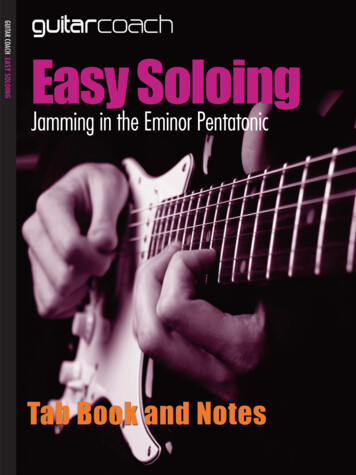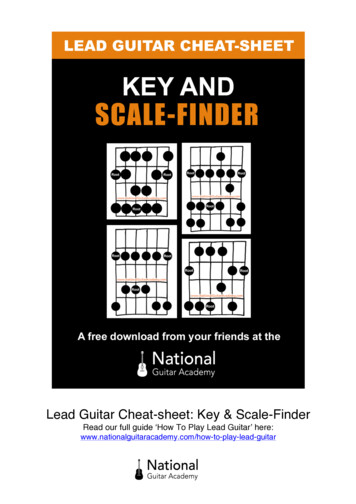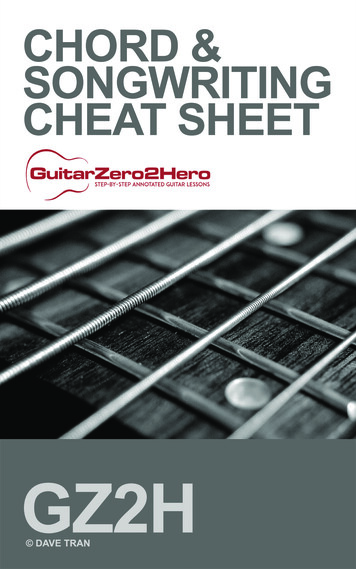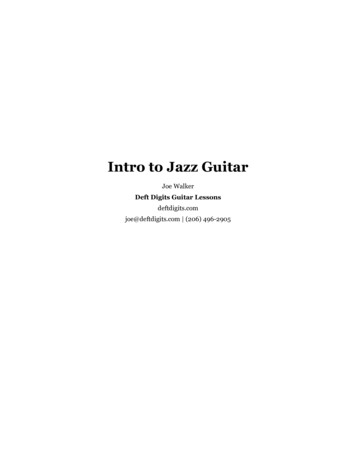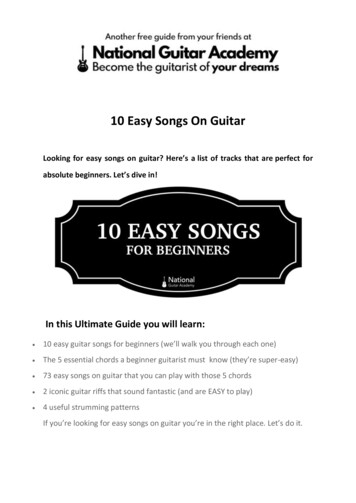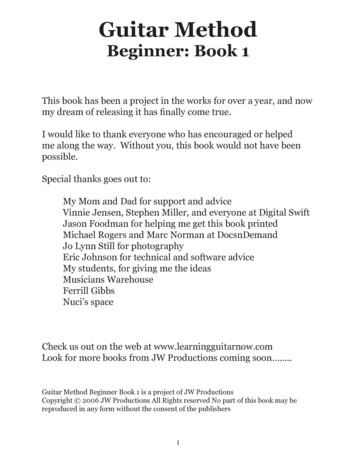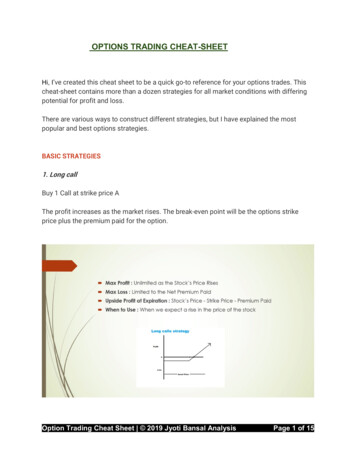
Transcription
ULTIMATE GUITAR SOLOINGCHEAT SHEET- WRITTEN MANUAL -
Page 2 of 29INTRODUCTION:This book of written lessons is an excellent tool and reference manual to develop and enhance your guitar skills.Use these instructional materials to help open up guitar avenues and to examine different chords and rhythms,lead guitar techniques, learning the fretboard, music theory,scales, and the world of playing over chord changes.If you don’t keep a practice log you want to start one for sure. A three ring binder with filler paper works best. Printout this booklet of written lessons and keep it with all other music reference materials in the three ring binder.Keep these items handy so you can refer to them when studying and practicing.Add filler paper to your binder and keep accurate records in your practice log of the items you are working on,what needs work, chord changes, progressions, songs, original material, scales, etc. Date the entries and keeptrack of your progress as you move forward in your guitar journey. Just like settings goals in life you want to setmusical goals and then go out there and achieve them.Remember to follow my structured curriculum, keep on practicing the right things, and keep developing your ear.Don’t overwhelm yourself by trying to take on too many new things at once. Take these lessons and techniques instages and slow and steady wins the race. Some of the more advanced lead guitar avenues will take time todigest.One of the keys is consistency. Keep trying to put those guitars in your hands every day, even if its only for 10-15minutes. You don’t necessarily need an hour block of time each day to learn guitar. Those little pockets of timewhere you have a spare ten minutes that you can practice really add up.Also make it easy for yourself to practice. Buy a guitar stand and keep your guitar out on the stand so it isaccessible to you at all times. Keep the guitar on the stand in a room you are in the most. This way you will bemuch more likely to grab it and practice when you have that free ten minute pocket of time. Don’t keep your guitarpacked up in its case under your bed or packed away in the closet. Leave it out and make it accessible.Like with anything new and different on the instrument dive into these materials with an open mind. Know that ifyou practice these techniques, work hard, keep honing your skills and refining your art that these methods willbring you results.Stay positive and remember that your guitar playing is an evolution. now let’s get to it!Copyright GuitarJamz Inc. - All rights reserved – unauthorized duplication or distribution of any part of this book is prohibited
Page 3 of 29TABLE OF CONTENTS:Written LessonPageIntroduction . 2Table of contents. 3Getting started. 4thChords – Dominant 7 chords . 5Notes on the fretboard . 6Lead Guitar – rhythm, the ride, note choice, & phrasing . 7Lead Guitar – the big Four . 8The choices when soloing . 9Key Signature and chord analyzing . 10Example progressions and soloing options – Major Key . 11-12Example progressions and soloing options – Minor Key . 13The Minor Pentatonic scale . 13The Minor Pentatonic Expanded I Scale . 14The Minor Pentatonic Expanded II Scale . 15The Minor Pentatonic scale – five box scales . 16The Major Pentatonic scale . . 17Major Pentatonic Sus4 scale . 18Major Pentatonic Sus4 scale links . 19Top ten key hints to get your playing to the next level . 20-22Chord construction . 23-24Circle of fifths . 25Blank tablature staff paper (document your favorite licks & riffs) . 27-29Copyright GuitarJamz Inc. - All rights reserved – unauthorized duplication or distribution of any part of this book is prohibited
Page 4 of 29GETTING STARTEDKeep in mind that I want to give you the most complete guitar curriculum possible. This does not mean you haveto master every lead guitar avenue or scale before moving on to the next. In these materials I teach many leadguitar avenues. Some will be more challenging than others and of course take more time to learn and apply. Butover time you will find the principles and techniques start to sink in and eventually will become automatic.With all the materials out there today and with the ease of locating materials online it sure can be overwhelming.So remember not to take on too much at once or you will become overwhelmed and frustrated. Slow and steadywins the race. You don’t want to rush things and then end up skimming over important topics leaving voids in yourplaying.It’s important to take the extra time to learn about the “why” things work as I write out in the lessons throughoutthis book. Learning the “why things work” will give you the musical knowledge to blast these principles andtechniques across all your playing. It will give you the lead guitar confidence to be able to instantly know whatavenues are possible when soloing and improvising.That’s the trick, to use these lessons as “templates” or “vehicles” to learn the why things work, and then developthem into your guitar arsenal through practical application. Then you have the tools to blast thes playingtechniques across all your playing at any given time, in any given jam, and in any given song.Don’t forget that as you further develop your lead guitar skills you also want to keep practicing and developingyour rhythm skills. Your rhythm and timing are critical elements to your overall abilities on the guitar. Never forgetthat your lead playing will really only ever be as good as your rhythm playing.As I dive further and further into lead guitar techniques and concepts in this book, keep in mind that these verysystematic and methodical techniques will seem a bit daunting at first. However, these will soon become secondnature and automatic, they will become engrained in your playing style. You wont have to think about what to playso much as it will eventually become second nature. Then you will be letting your ear take you to all the rightnotes and chords and not having to think about techniques and application so much but rather focus on emotionand feel in your playing. The more you practice and apply these materials the faster you will be on “autopilot”.That said, throughout my teaching career I have found that first learning things systematically will get yourplaying to the next level the fastest. Remember we are building your guitar chops and you need to have that solidfoundation to build upon as you move along in your guitar journey.Because many blues progressions utilize I-IV-V chord changes you will often be utilizing Minor Pentatonic & Bluesand/or Major Pentatonic as potential lead playing avenues. Pentatonic scales are killer scales to play over bluesand over I-IV-V changes. They just ooze that minor bluesy vibe or sweet major vibe.Many big name players and rock bands have made careers using pentatonic scales. However, I urge you to trysome of the other suggestions that I list, don’t limit yourself. You will also want to eventually learn the modes ofthe major scale. Modes like Dorian, Aeolian, and Mixolydian can sound awesome over Blues progressions whenutilized properly.KEY POINT: Keep in mind that at this stage of your lead guitar playing journey there is just no substitutefor practicing the right things, learning scales, studying the sounds and relationships between chordsand scales, developing your ear, practicing and honing your skills using jam tracks, and continuallypushing yourself and refining your art.Remember that your guitar playing is an evolution. Stay positive, keep with it, swing for the fences, and also giveyourself plenty of fun time on the guitar to go along with all the hard work and studying.YOU CAN DO IT!Copyright GuitarJamz Inc. - All rights reserved – unauthorized duplication or distribution of any part of this book is prohibited
Page 5 of 29NOTES ON THE BEG#C#DGCFADEdie Ate Dynamite Good Bye Edie# SHARPb FLATst1 Fret3rd fretth5 fret7th fretth9 fretEbG#C#F#BbEbEADGBEE and D stringsany note on the Edown and 2 fretsover and you havethe same note anoctave higher onthe D stringThe twelve-note scale consists of:A, Bb, B, C, C#, D, Eb, E, F, F#, G, G#Low E and High Estrings have samenote names on eachfret – just twooctaves apartA and G strings are related –from any note on the A stringgo 2 strings down and 2 fretsover and you have the samenote an octave higher on theG stringCopyright GuitarJamz Inc. - All rights reserved – unauthorized duplication or distribution of any part of this book is prohibited
Page 6 of 29LEAD GUITAR - Rhythm, The Ride, Note Choice, & PhrasingLead playing is something that can identify a player like a signature or fingerprint. Players like Stevie RayVaughan, Eddie Van Halen, BB King, Eric Clapton, Eric Johnson, Steve Vai, and Carlos Santana can be identifiedwith a single note. They have a very signature sound and identifiable guitar tone.As you continue your lead guitar studies and keep up with your practicing, you will find your playing will evolveover time – your playing is an evolution. An element of lead playing which may seem simple, like vibrato or stringbending, can takes months and months to develop into a signature statement in your lead guitar bag of tricks.GEAR/EQUIPMENT – Sometimes guitarists think that if they purchase the same guitar, amp, and effects of theirfavorite guitarist that they will cop their signature sound and replicate their tone. You will find that this is not thecase.Here is a quick story to illustrate this point. When Van Halen was first starting out they opened for some nameacts of the time. Eddie Van Halen was so revolutionary with his guitar playing that he virtually floored the guitarcommunity. One show Van Halen was opening for Ted Nugent and Ted watched in amazement as Eddie playedduring sound check. Ted couldn’t believe the sounds he was hearing. After Eddie left the stage Ted then talkedEddie’s guitar tech into letting him plug into Eddie’s rig. Ted Nugent starting playing through Eddie’s gear andguess what - he sounded like Ted Nugent.The point is that your tone comes mainly from your fingers and your technique, not the amp or effect. Tone is trulyin your hands and in your heart. Gear can surely be motivating and empowering and point you in a certaindirection, but ultimately your tone is in your hands.Eddie Van Halen can play any guitar through any amp or effect and will still sound like Eddie Van Halen. Youwant to play through the best gear that you can afford, but spend time developing your own technique and soundand not someone else’s.What you want to accomplish with your lead guitar playing and improvisation is two-fold:1. Complement the song – it all comes back to the song and how the guitar lines complement it and help to getits musical statement and emotions across.2. Draw people in to your solo – you want the listener to latch onto what you are playing. You want to keep thelistener on the edge of their seat wondering, “what is he going to play next”? You want to have the power to takethe listener on a musical journey with ups and downs and great emotion and passion. You want your leads to tella story. And of course you always want to be aware of melody happening in your guitar lines.At times many guitarists forget the above two items and are off soloing in their own “little world”. They forget aboutthe song, the chord changes, and what the other musicians behind them are doing. What happens then is thesong suffers, or the band has to “reel” the guitarist back into the groove.Below are four critical parts to great lead playing. Work on all four of these aspects by studying each individually,and then apply them in a musical context.Copyright GuitarJamz Inc. - All rights reserved – unauthorized duplication or distribution of any part of this book is prohibited
Page 7 of 29LEAD GUITAR - Rhythm, The Ride, Note Choice, & Phrasing – THE BIG FOUR1. Rhythm – the rhythm of your notes and licks. It’s the way we take the notes we choose to play and do thingsmusically with them. This quite possibly could be the most important element of lead guitar, taking the notes anddoing musically interesting things with them. Repetition is one key component and melody is another.Repetition is a key to good melody and phrasing. You don’
lead guitar techniques, learning the fretboard, music theory,scales, and the world of playing over chord changes. If you don’t keep a practice log you want to start one for sure. A three ring binder with filler paper works best. Print out this booklet of written lessons and keep it with all other music reference materials in the three ring binder. Keep these items handy so you can refer to .

